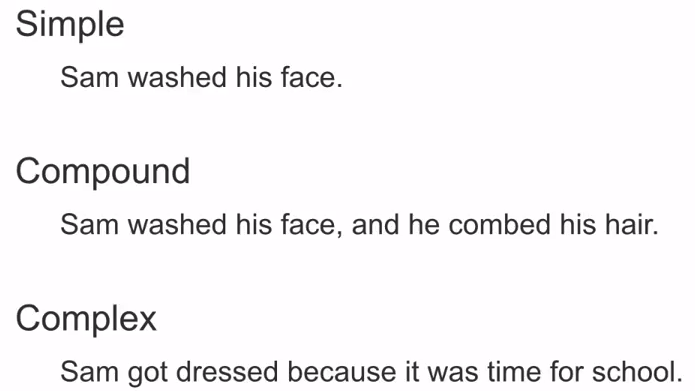引言
文章内容是 Academic English: Writing Specialization 课程笔记。
Conjunctions
一共有下图中3种类型的句子:1)Simple 类型的句子只有一个主语和一个动词,叫做 independent clause,这种类型的句子存在 series with 3 or more items 时,应该用逗号,比如:She bought apples, pears, and grapes 2)Compound 类型用连接词把2个 independent clause 连接起来,注意连接词前的逗号。3)Complex 类型由 independent clause and one or more dependent clauses 组成。
关于 Compound 类型的句子,又分为2种情况:1)用 conjunctions(比如:and, but, or, nor, yet, so)连接2个句子。这种情况下,连接词前面应该放上逗号。例句:The waiter brought us some water, and we looked at the menus. 2)用 transition words(比如:therefore, however, in addition, thus, furthermore, similarly, otherwise, then, nonetheless, also) 连接2个句子。这种情况下,连接词左面加分号,右面加逗号。例句:I was late to work; therefore, my boss is not happy. 这篇文章中 有更多这样的 transition words.
Adverb Clause
上面的小节中提到过,Complex 类型的句子应该有一个 independent clause 和至少一个 dependent clause. 下面2个句子是例句:
- While Sam washed his face, we listened to music.
- We li








 本文是 Coursera 'Academic English: Writing Specialization' 课程的笔记,涵盖并列句、从属句、逗号用法、平行结构、句子多样性以及论文写作的介绍、主体和结论段落。重点讲解了不同类型的句子结构,如并列句(conjunctions)、复杂句(adverb clause)以及逗号的多种用途。此外,还介绍了如何撰写比较对比、因果和论证类论文。
本文是 Coursera 'Academic English: Writing Specialization' 课程的笔记,涵盖并列句、从属句、逗号用法、平行结构、句子多样性以及论文写作的介绍、主体和结论段落。重点讲解了不同类型的句子结构,如并列句(conjunctions)、复杂句(adverb clause)以及逗号的多种用途。此外,还介绍了如何撰写比较对比、因果和论证类论文。

 最低0.47元/天 解锁文章
最低0.47元/天 解锁文章

















 235
235

 被折叠的 条评论
为什么被折叠?
被折叠的 条评论
为什么被折叠?








